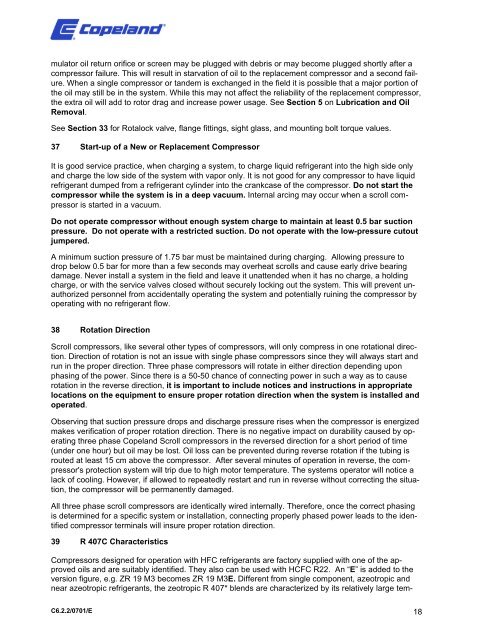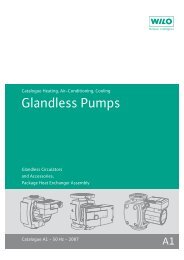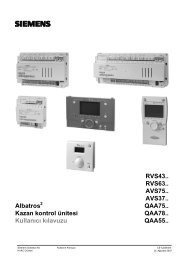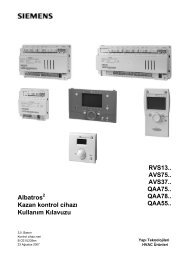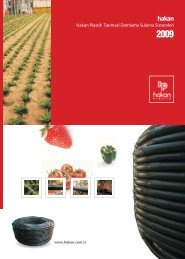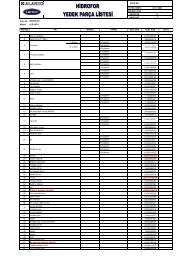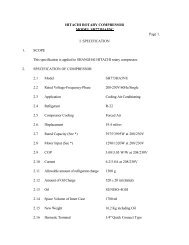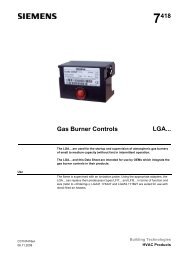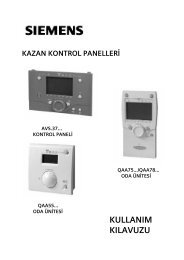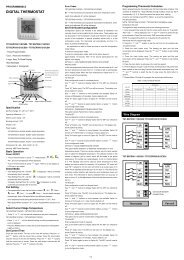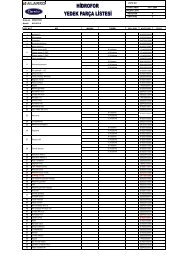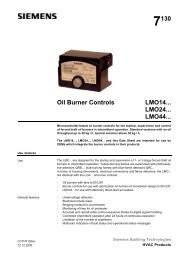A/C Scroll Compressors ZR 90 K4*.....ZR 300 KC*
A/C Scroll Compressors ZR 90 K4*.....ZR 300 KC*
A/C Scroll Compressors ZR 90 K4*.....ZR 300 KC*
You also want an ePaper? Increase the reach of your titles
YUMPU automatically turns print PDFs into web optimized ePapers that Google loves.
mulator oil return orifice or screen may be plugged with debris or may become plugged shortly after a<br />
compressor failure. This will result in starvation of oil to the replacement compressor and a second failure.<br />
When a single compressor or tandem is exchanged in the field it is possible that a major portion of<br />
the oil may still be in the system. While this may not affect the reliability of the replacement compressor,<br />
the extra oil will add to rotor drag and increase power usage. See Section 5 on Lubrication and Oil<br />
Removal.<br />
See Section 33 for Rotalock valve, flange fittings, sight glass, and mounting bolt torque values.<br />
37 Start-up of a New or Replacement Compressor<br />
It is good service practice, when charging a system, to charge liquid refrigerant into the high side only<br />
and charge the low side of the system with vapor only. It is not good for any compressor to have liquid<br />
refrigerant dumped from a refrigerant cylinder into the crankcase of the compressor. Do not start the<br />
compressor while the system is in a deep vacuum. Internal arcing may occur when a scroll compressor<br />
is started in a vacuum.<br />
Do not operate compressor without enough system charge to maintain at least 0.5 bar suction<br />
pressure. Do not operate with a restricted suction. Do not operate with the low-pressure cutout<br />
jumpered.<br />
A minimum suction pressure of 1.75 bar must be maintained during charging. Allowing pressure to<br />
drop below 0.5 bar for more than a few seconds may overheat scrolls and cause early drive bearing<br />
damage. Never install a system in the field and leave it unattended when it has no charge, a holding<br />
charge, or with the service valves closed without securely locking out the system. This will prevent unauthorized<br />
personnel from accidentally operating the system and potentially ruining the compressor by<br />
operating with no refrigerant flow.<br />
38 Rotation Direction<br />
<strong>Scroll</strong> compressors, like several other types of compressors, will only compress in one rotational direction.<br />
Direction of rotation is not an issue with single phase compressors since they will always start and<br />
run in the proper direction. Three phase compressors will rotate in either direction depending upon<br />
phasing of the power. Since there is a 50-50 chance of connecting power in such a way as to cause<br />
rotation in the reverse direction, it is important to include notices and instructions in appropriate<br />
locations on the equipment to ensure proper rotation direction when the system is installed and<br />
operated.<br />
Observing that suction pressure drops and discharge pressure rises when the compressor is energized<br />
makes verification of proper rotation direction. There is no negative impact on durability caused by operating<br />
three phase Copeland <strong>Scroll</strong> compressors in the reversed direction for a short period of time<br />
(under one hour) but oil may be lost. Oil loss can be prevented during reverse rotation if the tubing is<br />
routed at least 15 cm above the compressor. After several minutes of operation in reverse, the compressor's<br />
protection system will trip due to high motor temperature. The systems operator will notice a<br />
lack of cooling. However, if allowed to repeatedly restart and run in reverse without correcting the situation,<br />
the compressor will be permanently damaged.<br />
All three phase scroll compressors are identically wired internally. Therefore, once the correct phasing<br />
is determined for a specific system or installation, connecting properly phased power leads to the identified<br />
compressor terminals will insure proper rotation direction.<br />
39 R 407C Characteristics<br />
<strong>Compressors</strong> designed for operation with HFC refrigerants are factory supplied with one of the approved<br />
oils and are suitably identified. They also can be used with HCFC R22. An “E” is added to the<br />
version figure, e.g. <strong>ZR</strong> 19 M3 becomes <strong>ZR</strong> 19 M3E. Different from single component, azeotropic and<br />
near azeotropic refrigerants, the zeotropic R 407* blends are characterized by its relatively large tem-<br />
C6.2.2/0701/E 18


